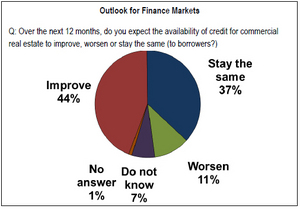The WPJ
THE WORLD PROPERTY JOURNALReal Estate Facts Not Fiction
Commercial Real Estate News

Debt Levels of Commercial Real Estate Borrowers Set to Increase 40% in 2012
Commercial News » North America Commercial News Edition | By Michael Gerrity | February 8, 2012 8:55 AM ET
 As lenders converge at the Mortgage Bankers Association conference in Atlanta this week, borrowers will keep a close eye on the amount of debt and equity capital raising planned by commercial banks, life companies and private investors in 2012.
As lenders converge at the Mortgage Bankers Association conference in Atlanta this week, borrowers will keep a close eye on the amount of debt and equity capital raising planned by commercial banks, life companies and private investors in 2012. To define the likely universe of capital available for commercial real estate lending in 2012, Jones Lang LaSalle and Penton Media Research partnered to conduct a proprietary survey that compiled direct feedback from 186 borrowers and 136 lenders that together comprise a median $73.3 million in commercial real estate asset value.
This report details the borrowers' sentiments for 2012 funding aims. In the last 12 months, these borrower respondents borrowed a median $21.1 million for commercial real estate ventures.
2012 Borrower Sentiment Highlights
- Borrowers find commercial banks are the most active lenders, as 77 percent of respondents borrowed from banks in 2011. One in three borrowed from life companies and one in four borrowed from private equity investors in 2011, signaling a trend expected to increase in 2012 as more borrowers seek funds from alternative sources.
- Most borrowers (74 percent) are sourcing primary loans or short-term construction loans (41 percent) followed by 30 percent sourcing a line of credit.
- The debt process is improving as commercial real estate borrowers report feeling satisfied with the certainty of execution from lenders, which they prioritize as the most important factor when seeking a loan origination provider.
- Expectations for an increase in long-term mortgage rates have subsided. Only 57 percent of borrowers predict an uptick in interest rates in 2012, while 78 percent thought rates would rise in 2011.
- Borrowers need more debt in 2012, as 40 percent expect their total portfolio debt to increase in 2012, up six percent over 2011 increase expectations.
- The health of the United States economy has the greatest impact on borrowers' ability to obtain financing.
"With $415 billion of mortgage maturities on the horizon in 2012 alone, and opportunistic plays in the market, it makes sense that a majority of borrowers still need more capital lending in 2012 and they're finding challenges that economic volatility throws at the commercial debt markets," predicts Tom Fish, Co-Head and Executive Managing Director of Jones Lang LaSalle's real estate investment banking business. "Even with the existing global economic concerns, debt financing will remain very strong in the core space from life companies and domestic banks and we expect the CMBS market to continue to regain footing in 2012."
Mike Melody, Co-Head and Executive Managing Director of Jones Lang LaSalle's real estate investment banking business concurs, "The traditional lenders are all still relatively cautious in their underwriting as they can still find good relative risk in mortgage loans relative to alternative bonds or other fixed-rate alternatives. That's resulting in bigger allocations to commercial real estate this year from the life companies and pension funds that have worked through most of their problem accounts and are well-positioned lenders in 2012."
Financing Requirements
In 2012, debt in all forms, deleveraging, bank stability and currency movements, will dominate the global financial picture. Domestic borrowers indicated the majority of their 2011 financing needs (51 percent) were used for refinancing, followed by 42 percent that financed acquisitions where opportunistic buys existed. Contrary to typical wisdom, a large portion of borrowers' funding in the last year went to new development (24 percent).
"Multifamily construction has already begun in several markets and some office product has launched as borrowers, developers and prime lenders prepare to start selective development in 2012," said Fish. "We won't see a wave of new construction hit the market but selective development makes financial sense where there are pockets of demand."
The increasing level of available credit is music to borrowers' ears as 44 percent of borrowers and 56 percent of lenders expect credit to increase in 2012.
Deal Execution
 To close deals today, borrowers state that lenders need to provide certainty of execution as the number one factor that nearly all borrower respondents consider in the loan origination process. Flexibility of loan terms ranks second and lowest available rate ranks third.
To close deals today, borrowers state that lenders need to provide certainty of execution as the number one factor that nearly all borrower respondents consider in the loan origination process. Flexibility of loan terms ranks second and lowest available rate ranks third. "Borrowers are making informed decisions as to lenders with whom they wish to transact. The debt markets are clearly improving and borrowers are able to secure attractive pricing from both bank and life company lenders who can be counted on to close," added Tom Melody, Co-Head and Executive Managing Director of Jones Lang LaSalle's real estate investment banking business. "The areas where we used to hear the most lamentation from borrowers related to the slow loan closing speed and the post-closing service process, which also scored the lowest satisfaction rate in our survey; however, both areas have improved as of late and we anticipate that improvement will continue throughout the year. It is a great time to be a borrower."
Rate Lock?
Borrowers' expectations for an increase in long-term mortgage rates have subsided. Only 57 percent of borrowers predict an uptick in interest rates in 2012, while 78 percent of respondents predicted interest rates would rise in 2011.
"Trying to predict the bond market is always somewhat dangerous, but the market is expecting rates to remain low during 2012 with generally favorable commercial loan pricing," added Mike Melody. "We're at an absolute 25-year low for fixed rate loans on the best, low leveraged, quality assets. Borrowers with core, well-located properties will have a lot of competition and bidding wars from lenders willing to be aggressive on their pricing even though absolute rates are low given the spreads to those benchmark interest rates are still extremely attractive."
The low interest rate environment is broadening the world of financeable assets because it helps support property values and results in lower cap rates, particularly for high-quality assets. Mike Melody cautions, "Remember that not all properties and all markets are created equal. There is still a remaining second tier of markets with unstabilized assets, and a less efficient debt market to finance them because the CMBS market that was financing that space paused in the back half of 2011. We believe CMBS will come back in 2012, but borrowers with those assets still have to face that market volatility in 2012."
Lingering Concerns
Among the greatest concerns for borrowers is the health of the U.S. economy as respondents indicated it had the most impact on their ability to obtain financing in 2011. Borrowers also noted that debt-service coverage ratios and loan to value ratios also impacted their ability to refinance.
Sign Up Free | The WPJ Weekly Newsletter
Relevant real estate news.
Actionable market intelligence.
Right to your inbox every week.
Real Estate Listings Showcase
Related News Stories
Commercial Real Estate Headlines
- 2025 Prediction: U.S. Commercial Investment Recovery Expected to Gain Traction
- Holiday Retail Sales for 2024 to Hit Record $1 Trillion
- Tech, AI Industries Drive Largest Share of Office Leasing Activity in U.S.
- Commercial Real Estate Lending in U.S. Enjoys Strong Growth in Q3
- U.S. Multifamily Market Begins Recovery in Q3
- Commercial Investment in Japan Spikes 24 Percent Annually in Q3
- Despite Return-to-Office Mandates, U.S. Office Vacancies Continue to Rise
- PROPSIG Tech Startup Acquired by World Property Data
- U.S. Commercial Mortgage Debt Hits $4.7 Trillion in Q2 as Delinquencies Increase
- Hong Kong Class A Office Rents Continue to Downtick in Mid-Summer
- U.S. Office Landlords Tenant Concessions Decline for First Time in 4 Years
- U.S. Commercial Mortgage Originations Spike 27 Percent in Q2 Over Q1
- Phnom Penh's Commercial Office, Retail Markets Face Slowdowns in 2024
- Global Edge Data Center Market to Hit $300 Billion by 2026
- Commercial Property Transactions in Japan Dive 25 Percent Annually in Q2
- Delinquency Rates for U.S. Commercial Property Loans Downticks in Q2
- Megawarehouse Lease Deals in U.S. Increase in 2024
- Office Tenants' Flight to Quality Buildings Increases in 2024
- Commercial Lending in Japan Upticks 6 Percent Annually in Q1
- AI Driving Significant Global Data Center Growth in 2024
- Total U.S. Commercial Mortgage Debt Rises to $4.7 Trillion in Q1
- U.S. Commercial Mortgage Delinquencies Rise in Early 2024
- Asia Pacific Office Sector to Further Reprice Throughout 2024
- U.S. Retail Foot Traffic to Surpass Pre-Pandemic Levels by 2025
- Commercial Real Estate Lending in U.S. Slowed in First Quarter
- Japan Commercial Property Investment Volume Jumps 7 Percent in Q1
- Asia Pacific Commercial Property Investment Leads the World, Spikes 13 Percent
- Driven by High Rates, U.S. Commercial Lending Imploded 47 Percent in 2023
- After Two Year Slump, Prime Multifamily Metrics Uptick in U.S.
- Commercial Co-Broker Commissions Not Affected by NAR-DOJ Settlement, Yet
- U.S. Office Buildings with Upscale Tenant Amenities Still Enjoy Premium Rents in 2024
- U.S. Commercial, Multifamily Mortgage Delinquency Rates Uptick in Q4
- U.S. Commercial Mortgage Debt Continued to Rise in 2023, Hits $4.7 Trillion
- Nonresidential Construction Spending in the U.S. Falls Sharply in January
- U.S. Multifamily Construction Starts to Decline in 2024
- Commercial Mortgage Lending in U.S. Shows Signs of Stabilization in Late 2023
- Architecture Billings Decline in December as Soft Business Conditions Persist
- Government Sector Claimed Largest Portion of 100 Biggest U.S. Office Leases Signed in 2023
- U.S. Commercial, Multifamily Borrowing Dives 25 Percent Annually in Late 2023
- Record High Multifamily Construction Deliveries Drive Vacancy Rates Higher
Reader Poll
Marketplace Links
This website uses cookies to improve user experience. By using our website you consent in accordance with our Cookie Policy. Read More





